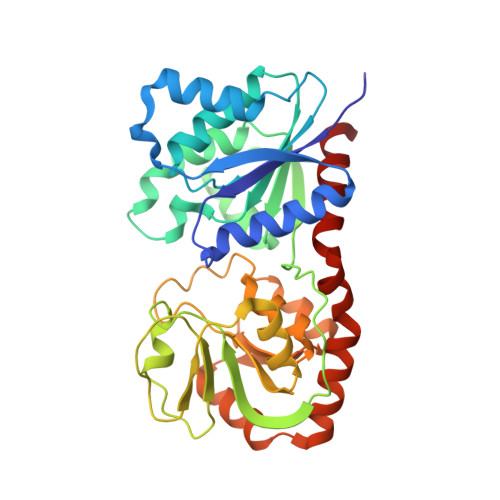A conserved domain is crucial for acceptor substrate binding in a family of glucosyltransferases.
Zhu, F., Zhang, H., Wu, H.(2015) J Bacteriol 197: 510-517
- PubMed: 25404702
- DOI: https://doi.org/10.1128/JB.02267-14
- Primary Citation of Related Structures:
4W6Q - PubMed Abstract:
Serine-rich repeat glycoproteins (SRRPs) are highly conserved in streptococci and staphylococci. Glycosylation of SRRPs is important for bacterial adhesion and pathogenesis. Streptococcus agalactiae is the leading cause of bacterial sepsis and meningitis among newborns. Srr2, an SRRP from S. agalactiae strain COH1, has been implicated in bacterial virulence. Four genes (gtfA, gtfB, gtfC, and gtfD) located downstream of srr2 share significant homology with genes involved in glycosylation of other SRRPs. We have shown previously that gtfA and gtfB encode two glycosyltransferases, GtfA and GtfB, that catalyze the transfer of GlcNAc residues to the Srr2 polypeptide. However, the function of other glycosyltransferases in glycosylation of Srr2 is unknown. In this study, we determined that GtfC catalyzed the direct transfer of glucosyl residues to Srr2-GlcNAc. The GtfC crystal structure was solved at 2.7 Å by molecular replacement. Structural analysis revealed a loop region at the N terminus as a putative acceptor substrate binding domain. Deletion of this domain rendered GtfC unable to bind to its substrate Srr2-GlcNAc, concurrently abolished the glycosyltransferase activity of GtfC, and also altered glycosylation of Srr2. Furthermore, deletion of the corresponding regions from GtfC homologs also abolished their substrate binding and enzymatic activity, indicating that this region is functionally conserved. In summary, we have determined that GtfC is important for the glycosylation of Srr2 and identified a conserved loop region that is crucial for acceptor substrate binding from GtfC homologs in streptococci. These findings shed new mechanistic insight into this family of glycosyltransferases.
Organizational Affiliation:
Department of Pediatric Dentistry, Schools of Dentistry and Medicine, University of Alabama at Birmingham, Birmingham, Alabama, USA Department of Microbiology, Schools of Dentistry and Medicine, University of Alabama at Birmingham, Birmingham, Alabama, USA.
















